Comprehensive Report: Nestle's Business Environment and Operations
VerifiedAdded on 2020/06/06
|19
|5328
|110
Report
AI Summary
This report provides a comprehensive analysis of Nestle's business environment, examining its organizational structure, internal strengths, and external influences. The report begins with an introduction to the concept of the business environment, including its various components such as employees, clients, competitors, suppliers, laws, government bodies, and technology. It then delves into different types of organizations like limited companies, charities (using Cancer Research UK as an example), and public companies (Department of Health UK). The report explores the growth of the international business environment, including factors like market saturation, expansion into foreign markets, advancements in communication and technology, and reduction in trade barriers. The analysis of Nestle includes its mission, vision, objectives, and organizational structure, along with stakeholder analysis. The report concludes with a discussion on the impact of the business environment on Nestle's operations and provides references for further study.
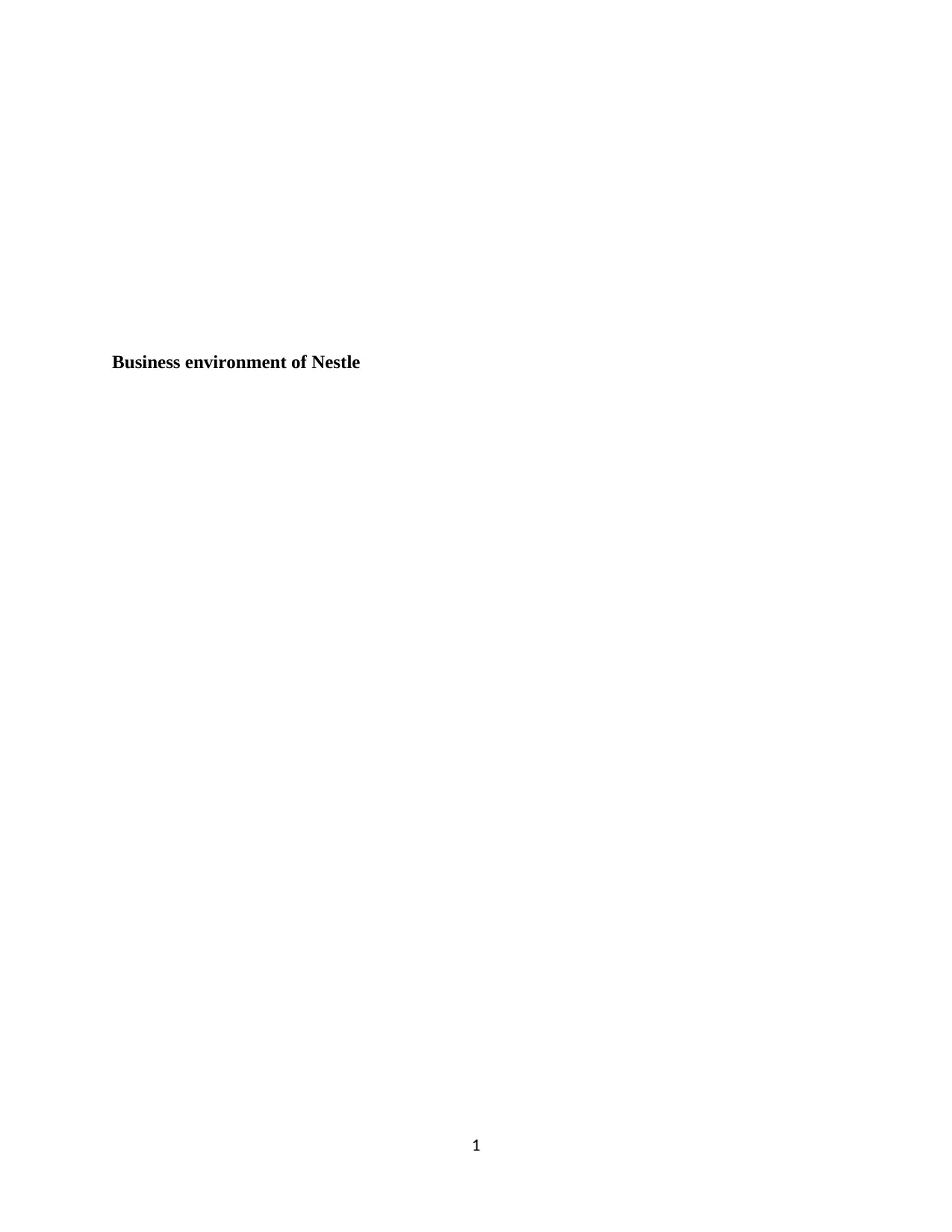
Business environment of Nestle
1
1
Paraphrase This Document
Need a fresh take? Get an instant paraphrase of this document with our AI Paraphraser
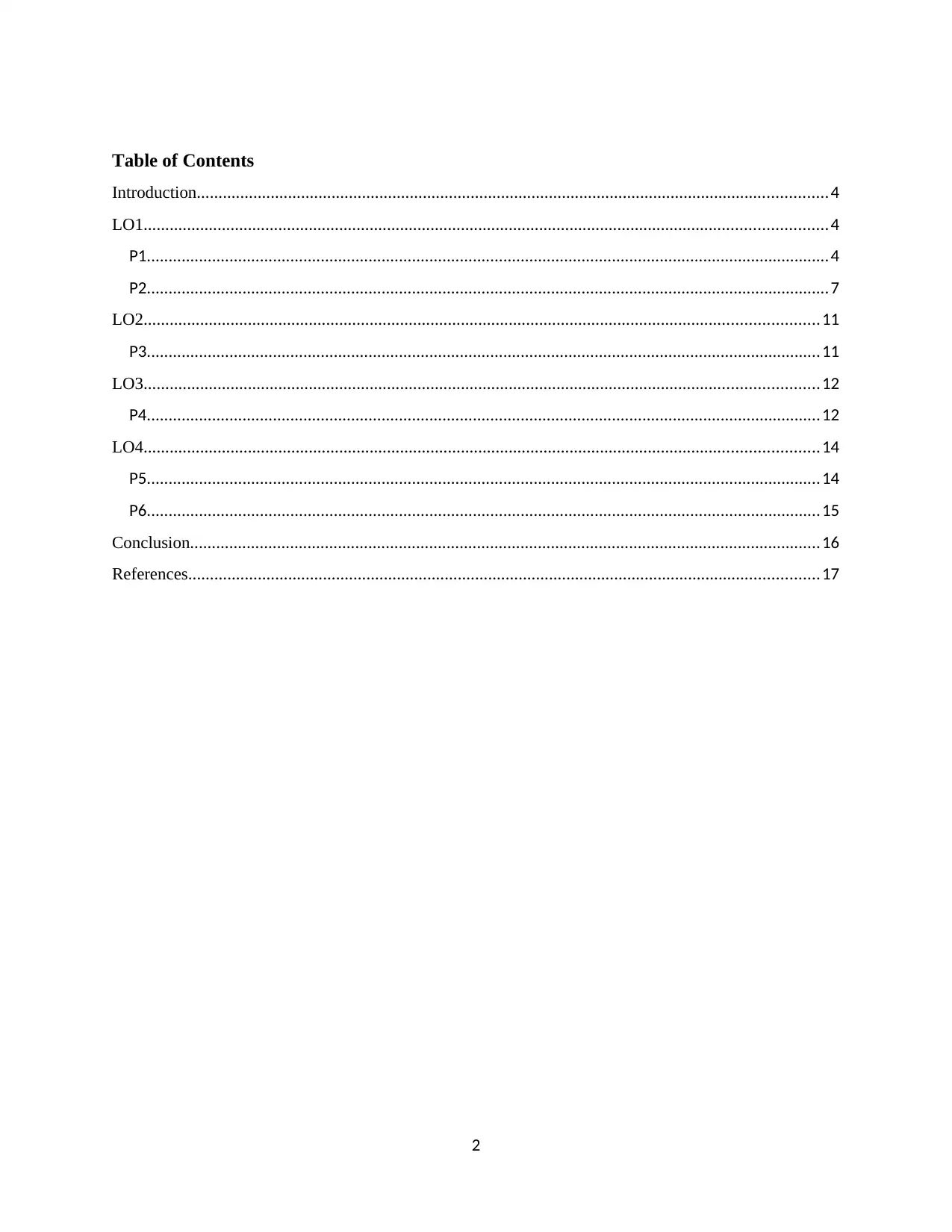
Table of Contents
Introduction.................................................................................................................................................4
LO1.............................................................................................................................................................4
P1.............................................................................................................................................................4
P2.............................................................................................................................................................7
LO2...........................................................................................................................................................11
P3...........................................................................................................................................................11
LO3...........................................................................................................................................................12
P4...........................................................................................................................................................12
LO4...........................................................................................................................................................14
P5...........................................................................................................................................................14
P6...........................................................................................................................................................15
Conclusion.................................................................................................................................................16
References.................................................................................................................................................17
2
Introduction.................................................................................................................................................4
LO1.............................................................................................................................................................4
P1.............................................................................................................................................................4
P2.............................................................................................................................................................7
LO2...........................................................................................................................................................11
P3...........................................................................................................................................................11
LO3...........................................................................................................................................................12
P4...........................................................................................................................................................12
LO4...........................................................................................................................................................14
P5...........................................................................................................................................................14
P6...........................................................................................................................................................15
Conclusion.................................................................................................................................................16
References.................................................................................................................................................17
2
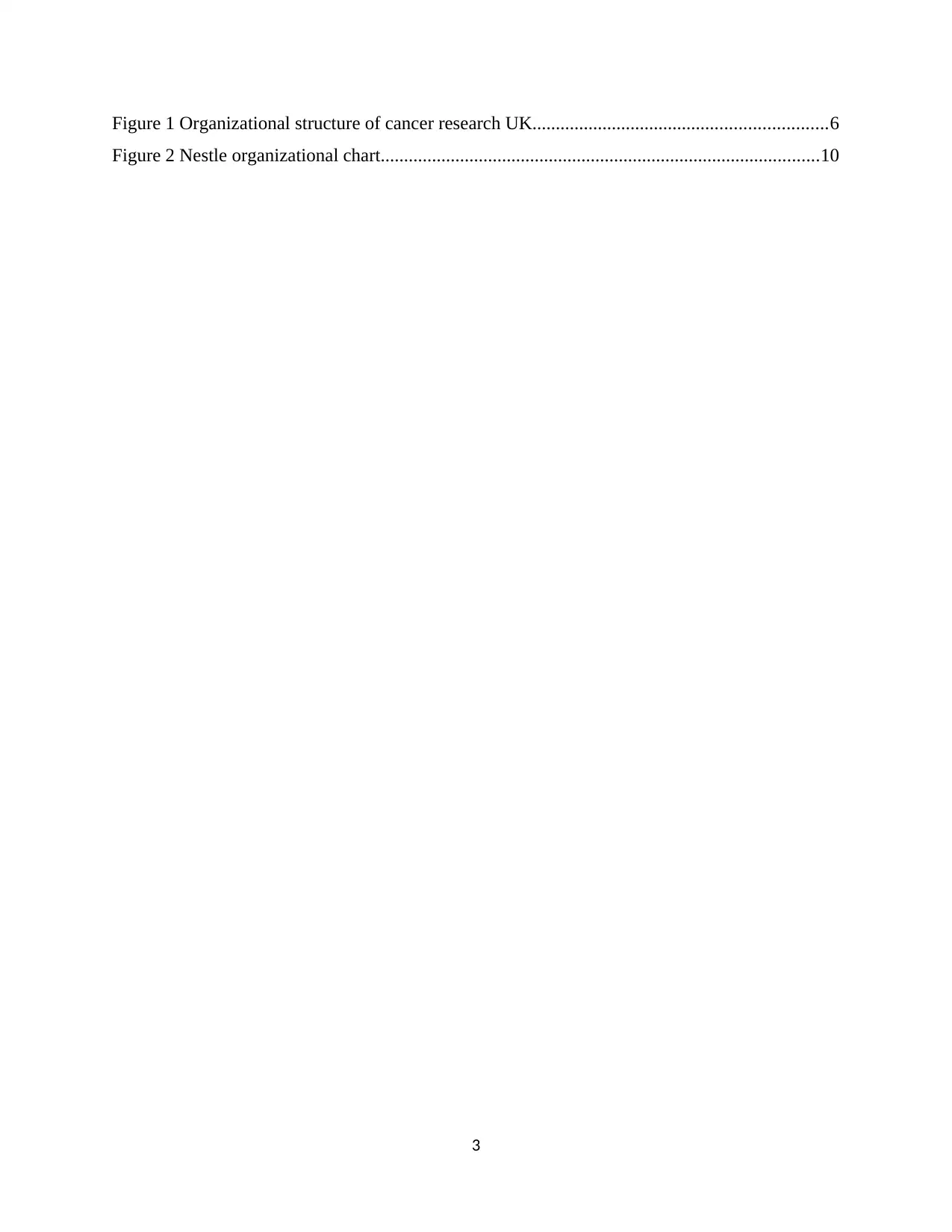
Figure 1 Organizational structure of cancer research UK...............................................................6
Figure 2 Nestle organizational chart..............................................................................................10
3
Figure 2 Nestle organizational chart..............................................................................................10
3
⊘ This is a preview!⊘
Do you want full access?
Subscribe today to unlock all pages.

Trusted by 1+ million students worldwide
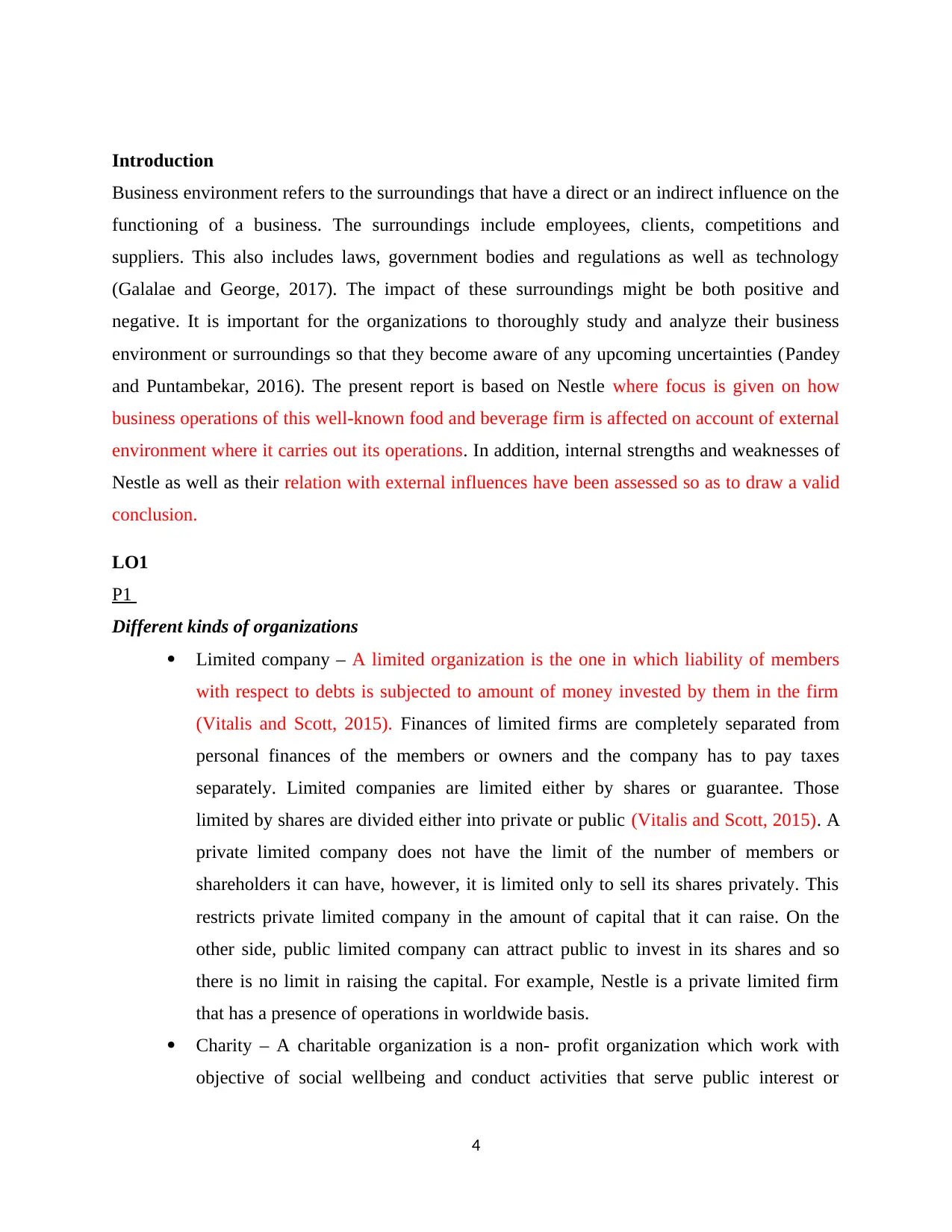
Introduction
Business environment refers to the surroundings that have a direct or an indirect influence on the
functioning of a business. The surroundings include employees, clients, competitions and
suppliers. This also includes laws, government bodies and regulations as well as technology
(Galalae and George, 2017). The impact of these surroundings might be both positive and
negative. It is important for the organizations to thoroughly study and analyze their business
environment or surroundings so that they become aware of any upcoming uncertainties (Pandey
and Puntambekar, 2016). The present report is based on Nestle where focus is given on how
business operations of this well-known food and beverage firm is affected on account of external
environment where it carries out its operations. In addition, internal strengths and weaknesses of
Nestle as well as their relation with external influences have been assessed so as to draw a valid
conclusion.
LO1
P1
Different kinds of organizations
Limited company – A limited organization is the one in which liability of members
with respect to debts is subjected to amount of money invested by them in the firm
(Vitalis and Scott, 2015). Finances of limited firms are completely separated from
personal finances of the members or owners and the company has to pay taxes
separately. Limited companies are limited either by shares or guarantee. Those
limited by shares are divided either into private or public (Vitalis and Scott, 2015). A
private limited company does not have the limit of the number of members or
shareholders it can have, however, it is limited only to sell its shares privately. This
restricts private limited company in the amount of capital that it can raise. On the
other side, public limited company can attract public to invest in its shares and so
there is no limit in raising the capital. For example, Nestle is a private limited firm
that has a presence of operations in worldwide basis.
Charity – A charitable organization is a non- profit organization which work with
objective of social wellbeing and conduct activities that serve public interest or
4
Business environment refers to the surroundings that have a direct or an indirect influence on the
functioning of a business. The surroundings include employees, clients, competitions and
suppliers. This also includes laws, government bodies and regulations as well as technology
(Galalae and George, 2017). The impact of these surroundings might be both positive and
negative. It is important for the organizations to thoroughly study and analyze their business
environment or surroundings so that they become aware of any upcoming uncertainties (Pandey
and Puntambekar, 2016). The present report is based on Nestle where focus is given on how
business operations of this well-known food and beverage firm is affected on account of external
environment where it carries out its operations. In addition, internal strengths and weaknesses of
Nestle as well as their relation with external influences have been assessed so as to draw a valid
conclusion.
LO1
P1
Different kinds of organizations
Limited company – A limited organization is the one in which liability of members
with respect to debts is subjected to amount of money invested by them in the firm
(Vitalis and Scott, 2015). Finances of limited firms are completely separated from
personal finances of the members or owners and the company has to pay taxes
separately. Limited companies are limited either by shares or guarantee. Those
limited by shares are divided either into private or public (Vitalis and Scott, 2015). A
private limited company does not have the limit of the number of members or
shareholders it can have, however, it is limited only to sell its shares privately. This
restricts private limited company in the amount of capital that it can raise. On the
other side, public limited company can attract public to invest in its shares and so
there is no limit in raising the capital. For example, Nestle is a private limited firm
that has a presence of operations in worldwide basis.
Charity – A charitable organization is a non- profit organization which work with
objective of social wellbeing and conduct activities that serve public interest or
4
Paraphrase This Document
Need a fresh take? Get an instant paraphrase of this document with our AI Paraphraser
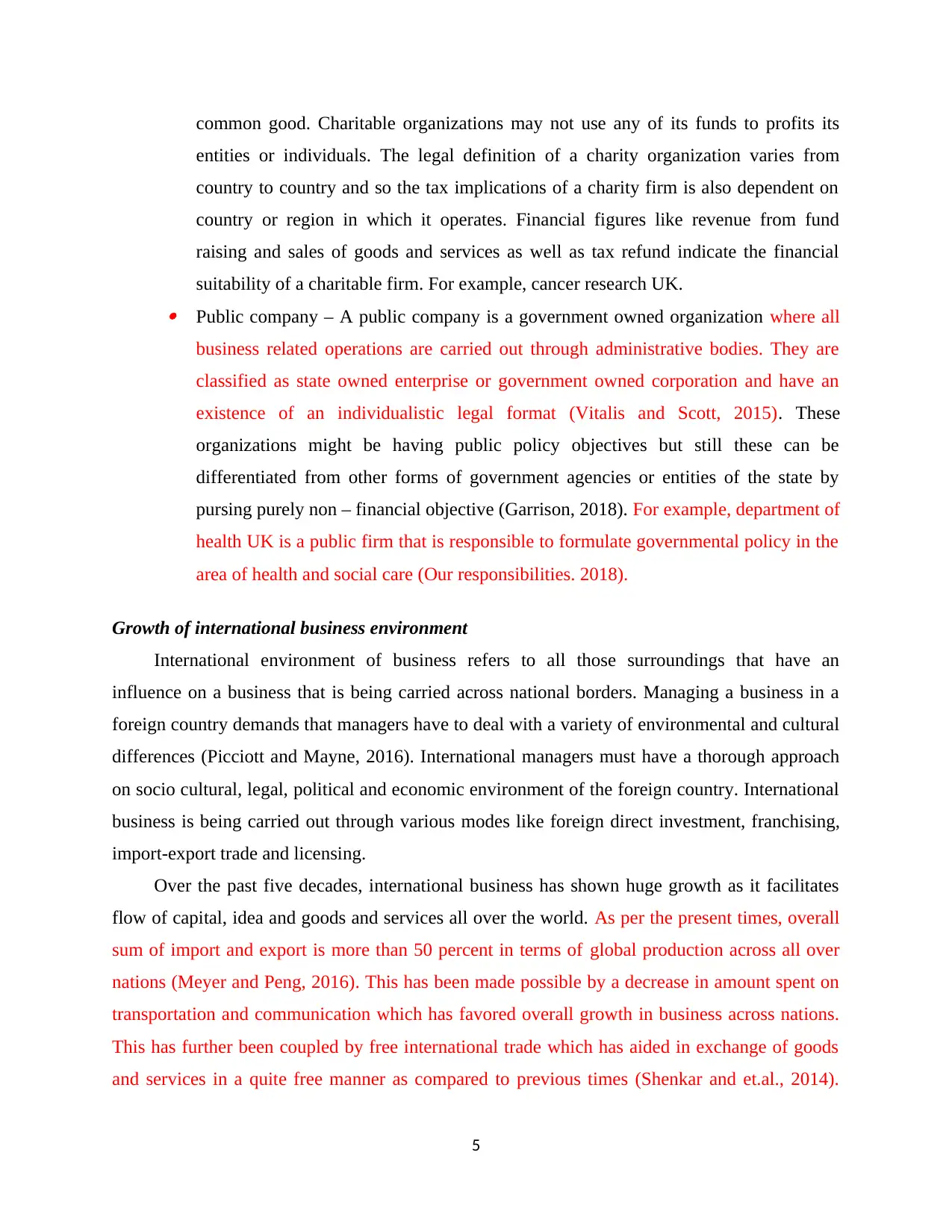
common good. Charitable organizations may not use any of its funds to profits its
entities or individuals. The legal definition of a charity organization varies from
country to country and so the tax implications of a charity firm is also dependent on
country or region in which it operates. Financial figures like revenue from fund
raising and sales of goods and services as well as tax refund indicate the financial
suitability of a charitable firm. For example, cancer research UK.
Public company – A public company is a government owned organization where all
business related operations are carried out through administrative bodies. They are
classified as state owned enterprise or government owned corporation and have an
existence of an individualistic legal format (Vitalis and Scott, 2015). These
organizations might be having public policy objectives but still these can be
differentiated from other forms of government agencies or entities of the state by
pursing purely non – financial objective (Garrison, 2018). For example, department of
health UK is a public firm that is responsible to formulate governmental policy in the
area of health and social care (Our responsibilities. 2018).
Growth of international business environment
International environment of business refers to all those surroundings that have an
influence on a business that is being carried across national borders. Managing a business in a
foreign country demands that managers have to deal with a variety of environmental and cultural
differences (Picciott and Mayne, 2016). International managers must have a thorough approach
on socio cultural, legal, political and economic environment of the foreign country. International
business is being carried out through various modes like foreign direct investment, franchising,
import-export trade and licensing.
Over the past five decades, international business has shown huge growth as it facilitates
flow of capital, idea and goods and services all over the world. As per the present times, overall
sum of import and export is more than 50 percent in terms of global production across all over
nations (Meyer and Peng, 2016). This has been made possible by a decrease in amount spent on
transportation and communication which has favored overall growth in business across nations.
This has further been coupled by free international trade which has aided in exchange of goods
and services in a quite free manner as compared to previous times (Shenkar and et.al., 2014).
5
entities or individuals. The legal definition of a charity organization varies from
country to country and so the tax implications of a charity firm is also dependent on
country or region in which it operates. Financial figures like revenue from fund
raising and sales of goods and services as well as tax refund indicate the financial
suitability of a charitable firm. For example, cancer research UK.
Public company – A public company is a government owned organization where all
business related operations are carried out through administrative bodies. They are
classified as state owned enterprise or government owned corporation and have an
existence of an individualistic legal format (Vitalis and Scott, 2015). These
organizations might be having public policy objectives but still these can be
differentiated from other forms of government agencies or entities of the state by
pursing purely non – financial objective (Garrison, 2018). For example, department of
health UK is a public firm that is responsible to formulate governmental policy in the
area of health and social care (Our responsibilities. 2018).
Growth of international business environment
International environment of business refers to all those surroundings that have an
influence on a business that is being carried across national borders. Managing a business in a
foreign country demands that managers have to deal with a variety of environmental and cultural
differences (Picciott and Mayne, 2016). International managers must have a thorough approach
on socio cultural, legal, political and economic environment of the foreign country. International
business is being carried out through various modes like foreign direct investment, franchising,
import-export trade and licensing.
Over the past five decades, international business has shown huge growth as it facilitates
flow of capital, idea and goods and services all over the world. As per the present times, overall
sum of import and export is more than 50 percent in terms of global production across all over
nations (Meyer and Peng, 2016). This has been made possible by a decrease in amount spent on
transportation and communication which has favored overall growth in business across nations.
This has further been coupled by free international trade which has aided in exchange of goods
and services in a quite free manner as compared to previous times (Shenkar and et.al., 2014).
5
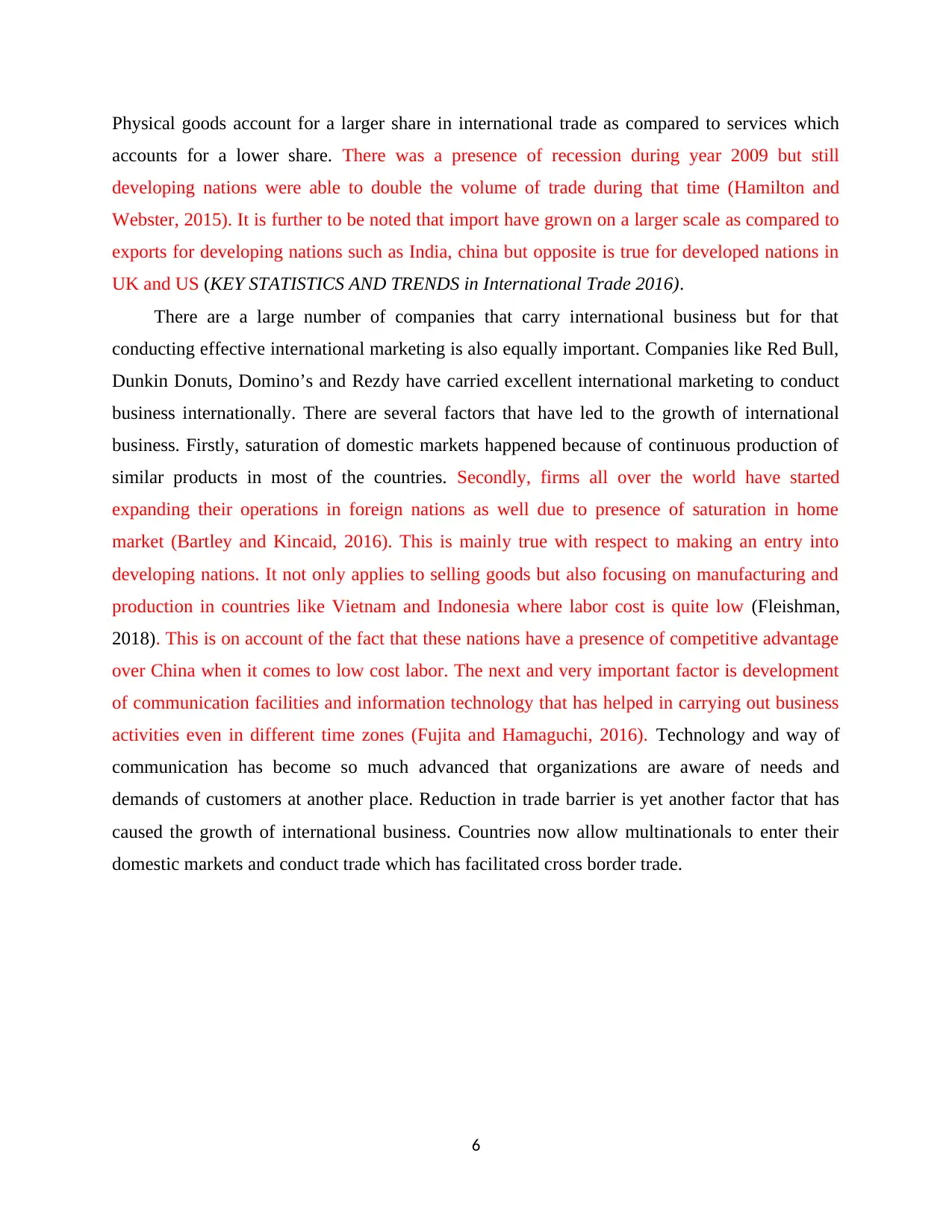
Physical goods account for a larger share in international trade as compared to services which
accounts for a lower share. There was a presence of recession during year 2009 but still
developing nations were able to double the volume of trade during that time (Hamilton and
Webster, 2015). It is further to be noted that import have grown on a larger scale as compared to
exports for developing nations such as India, china but opposite is true for developed nations in
UK and US (KEY STATISTICS AND TRENDS in International Trade 2016).
There are a large number of companies that carry international business but for that
conducting effective international marketing is also equally important. Companies like Red Bull,
Dunkin Donuts, Domino’s and Rezdy have carried excellent international marketing to conduct
business internationally. There are several factors that have led to the growth of international
business. Firstly, saturation of domestic markets happened because of continuous production of
similar products in most of the countries. Secondly, firms all over the world have started
expanding their operations in foreign nations as well due to presence of saturation in home
market (Bartley and Kincaid, 2016). This is mainly true with respect to making an entry into
developing nations. It not only applies to selling goods but also focusing on manufacturing and
production in countries like Vietnam and Indonesia where labor cost is quite low (Fleishman,
2018). This is on account of the fact that these nations have a presence of competitive advantage
over China when it comes to low cost labor. The next and very important factor is development
of communication facilities and information technology that has helped in carrying out business
activities even in different time zones (Fujita and Hamaguchi, 2016). Technology and way of
communication has become so much advanced that organizations are aware of needs and
demands of customers at another place. Reduction in trade barrier is yet another factor that has
caused the growth of international business. Countries now allow multinationals to enter their
domestic markets and conduct trade which has facilitated cross border trade.
6
accounts for a lower share. There was a presence of recession during year 2009 but still
developing nations were able to double the volume of trade during that time (Hamilton and
Webster, 2015). It is further to be noted that import have grown on a larger scale as compared to
exports for developing nations such as India, china but opposite is true for developed nations in
UK and US (KEY STATISTICS AND TRENDS in International Trade 2016).
There are a large number of companies that carry international business but for that
conducting effective international marketing is also equally important. Companies like Red Bull,
Dunkin Donuts, Domino’s and Rezdy have carried excellent international marketing to conduct
business internationally. There are several factors that have led to the growth of international
business. Firstly, saturation of domestic markets happened because of continuous production of
similar products in most of the countries. Secondly, firms all over the world have started
expanding their operations in foreign nations as well due to presence of saturation in home
market (Bartley and Kincaid, 2016). This is mainly true with respect to making an entry into
developing nations. It not only applies to selling goods but also focusing on manufacturing and
production in countries like Vietnam and Indonesia where labor cost is quite low (Fleishman,
2018). This is on account of the fact that these nations have a presence of competitive advantage
over China when it comes to low cost labor. The next and very important factor is development
of communication facilities and information technology that has helped in carrying out business
activities even in different time zones (Fujita and Hamaguchi, 2016). Technology and way of
communication has become so much advanced that organizations are aware of needs and
demands of customers at another place. Reduction in trade barrier is yet another factor that has
caused the growth of international business. Countries now allow multinationals to enter their
domestic markets and conduct trade which has facilitated cross border trade.
6
⊘ This is a preview!⊘
Do you want full access?
Subscribe today to unlock all pages.

Trusted by 1+ million students worldwide

P2
Cancer research UK
Cancer research UK is a charity organization that carries out research activities in cancer so as to
bring a cure to this global menace. It was formulated in year 2002 and provides services in the
area of cancer therapeutics; vaccinations; technologies as well as diagnostics. It further conducts
research for preventing, diagnosing as well as treating this disease with help of cancer care
centers, research institutes, clinics as well as hospitals. Focus is also given on generating data
related to cancer and carrying out activities so as to increase general awareness among the public
about this disease. In terms of size, the company operates through a network of more than 85
centers that have a presence all around United Kingdom. As per the scope, it has been named as
the largest cancer research Centre in the world that runs on charity and has got presence of
independent operations. Its working is funded entirely by the public. The company is further
spending 2 million pounds on research in Belfast where focus is given on bowel and prostate
cancer; radiotherapy as well as personalized treatments (Cancer Research UK, 2018). The
working of cancer research UK is further supported by 4000 plus scientists, doctors as well as
nurses that can serve the cancer victims in UK. As per its mission, the firm wants survival within
UK to become the best in the world. While, its vision is to look forward to the day when the
entire world will be cured of cancer. On the basis of these, the company has formulated an
objective which is to reduce number of deaths caused by Cancer.
7
Cancer research UK
Cancer research UK is a charity organization that carries out research activities in cancer so as to
bring a cure to this global menace. It was formulated in year 2002 and provides services in the
area of cancer therapeutics; vaccinations; technologies as well as diagnostics. It further conducts
research for preventing, diagnosing as well as treating this disease with help of cancer care
centers, research institutes, clinics as well as hospitals. Focus is also given on generating data
related to cancer and carrying out activities so as to increase general awareness among the public
about this disease. In terms of size, the company operates through a network of more than 85
centers that have a presence all around United Kingdom. As per the scope, it has been named as
the largest cancer research Centre in the world that runs on charity and has got presence of
independent operations. Its working is funded entirely by the public. The company is further
spending 2 million pounds on research in Belfast where focus is given on bowel and prostate
cancer; radiotherapy as well as personalized treatments (Cancer Research UK, 2018). The
working of cancer research UK is further supported by 4000 plus scientists, doctors as well as
nurses that can serve the cancer victims in UK. As per its mission, the firm wants survival within
UK to become the best in the world. While, its vision is to look forward to the day when the
entire world will be cured of cancer. On the basis of these, the company has formulated an
objective which is to reduce number of deaths caused by Cancer.
7
Paraphrase This Document
Need a fresh take? Get an instant paraphrase of this document with our AI Paraphraser
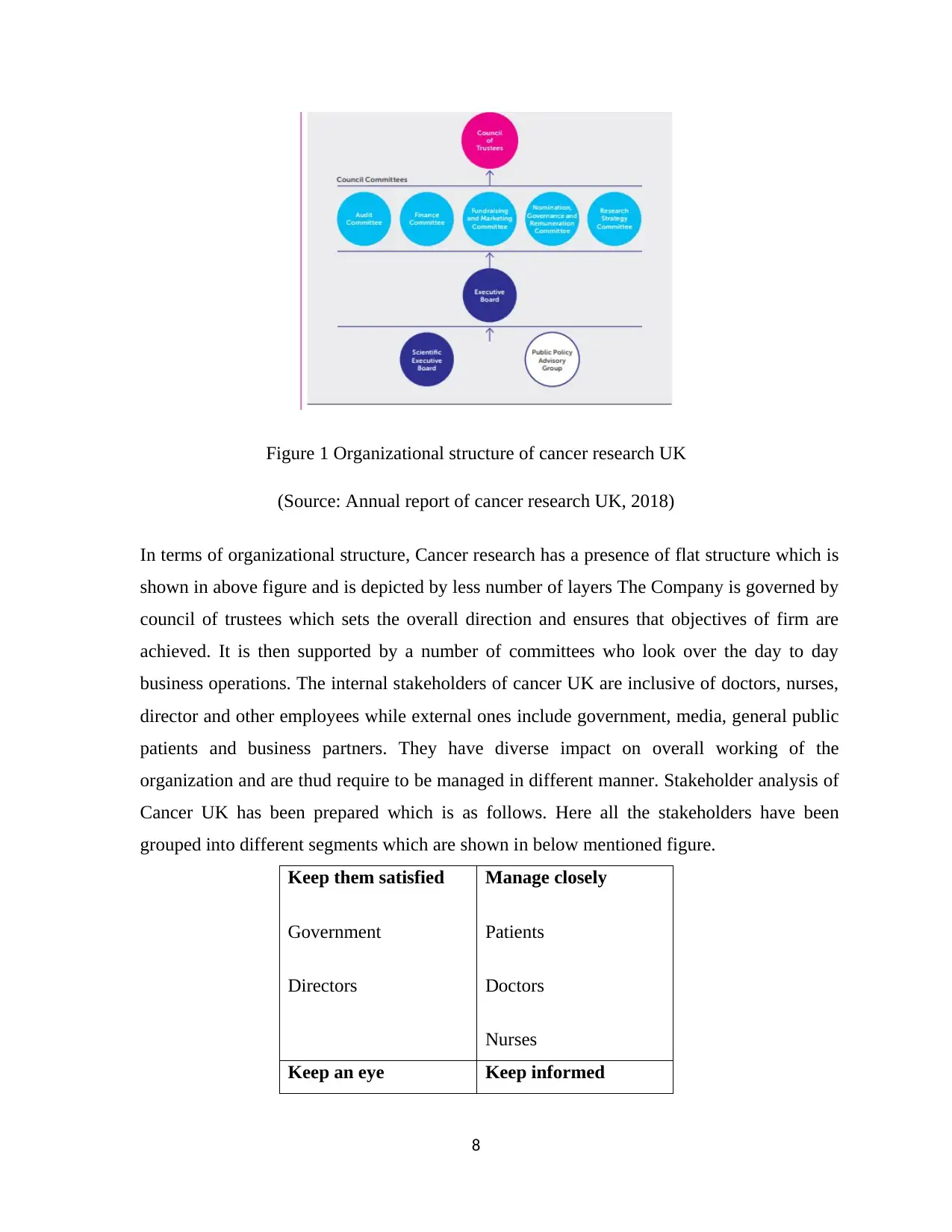
Figure 1 Organizational structure of cancer research UK
(Source: Annual report of cancer research UK, 2018)
In terms of organizational structure, Cancer research has a presence of flat structure which is
shown in above figure and is depicted by less number of layers The Company is governed by
council of trustees which sets the overall direction and ensures that objectives of firm are
achieved. It is then supported by a number of committees who look over the day to day
business operations. The internal stakeholders of cancer UK are inclusive of doctors, nurses,
director and other employees while external ones include government, media, general public
patients and business partners. They have diverse impact on overall working of the
organization and are thud require to be managed in different manner. Stakeholder analysis of
Cancer UK has been prepared which is as follows. Here all the stakeholders have been
grouped into different segments which are shown in below mentioned figure.
Keep them satisfied
Government
Directors
Manage closely
Patients
Doctors
Nurses
Keep an eye Keep informed
8
(Source: Annual report of cancer research UK, 2018)
In terms of organizational structure, Cancer research has a presence of flat structure which is
shown in above figure and is depicted by less number of layers The Company is governed by
council of trustees which sets the overall direction and ensures that objectives of firm are
achieved. It is then supported by a number of committees who look over the day to day
business operations. The internal stakeholders of cancer UK are inclusive of doctors, nurses,
director and other employees while external ones include government, media, general public
patients and business partners. They have diverse impact on overall working of the
organization and are thud require to be managed in different manner. Stakeholder analysis of
Cancer UK has been prepared which is as follows. Here all the stakeholders have been
grouped into different segments which are shown in below mentioned figure.
Keep them satisfied
Government
Directors
Manage closely
Patients
Doctors
Nurses
Keep an eye Keep informed
8

Volunteers
Business partners
Trustee
Donors
Employees
Nestle
Nestle in the largest food and beverage firm of the world that has more than 2000 brands and it
serves in over 191 nations (Pandey and Puntambekar, 2016). It offers products such as bottled
water, breakfast cereals, and chocolates, coffee, dairy, food and drink products among others.
The mission of nestle is to provide good food as well as good life to masses. On the other hand,
its vision is to lead food and beverage sector and become number one brand in the world that
provides products and services related to fitness, nourishment and well-being (Miah and et.al.,
2015). The objective of the company is to enhance the overall life quality of people and
contributing towards a better future. The company adheres with decentralized and matrix
organizational structure. It thus permits the employees to have a higher degree of work related
independence. Still major strategies are made at headquarter level while the decisions related to
every day operations are in the hands of subordinate branches (Pandey and Puntambekar, 2016).
There is a presence of many stakeholders at Nestle whose analysis is as follows;
Keep them satisfied
Government
Consumers
Manage closely
Employees
Keep an eye
Competitors
Business partners
Keep informal
Media
Shareholders
Department of health
9
Business partners
Trustee
Donors
Employees
Nestle
Nestle in the largest food and beverage firm of the world that has more than 2000 brands and it
serves in over 191 nations (Pandey and Puntambekar, 2016). It offers products such as bottled
water, breakfast cereals, and chocolates, coffee, dairy, food and drink products among others.
The mission of nestle is to provide good food as well as good life to masses. On the other hand,
its vision is to lead food and beverage sector and become number one brand in the world that
provides products and services related to fitness, nourishment and well-being (Miah and et.al.,
2015). The objective of the company is to enhance the overall life quality of people and
contributing towards a better future. The company adheres with decentralized and matrix
organizational structure. It thus permits the employees to have a higher degree of work related
independence. Still major strategies are made at headquarter level while the decisions related to
every day operations are in the hands of subordinate branches (Pandey and Puntambekar, 2016).
There is a presence of many stakeholders at Nestle whose analysis is as follows;
Keep them satisfied
Government
Consumers
Manage closely
Employees
Keep an eye
Competitors
Business partners
Keep informal
Media
Shareholders
Department of health
9
⊘ This is a preview!⊘
Do you want full access?
Subscribe today to unlock all pages.

Trusted by 1+ million students worldwide
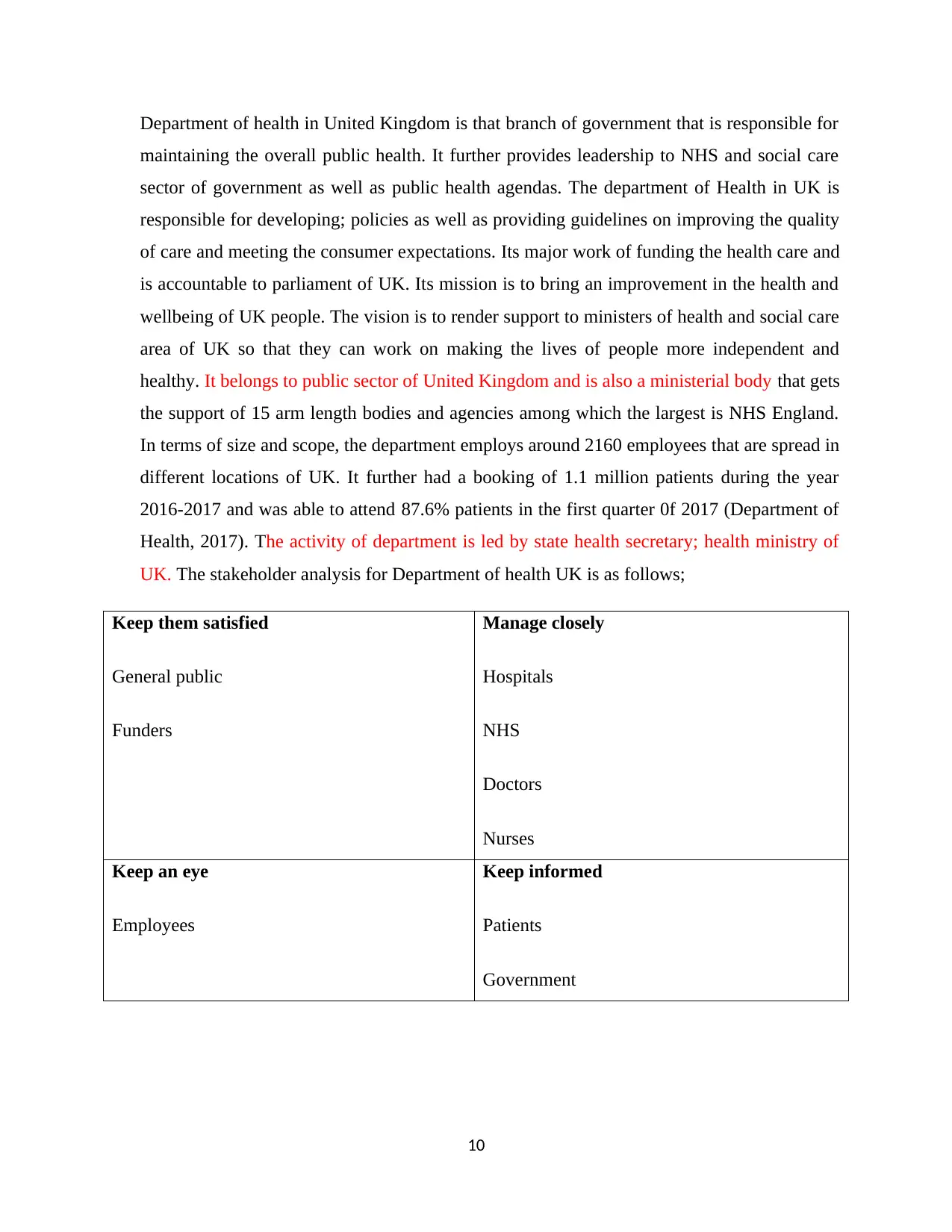
Department of health in United Kingdom is that branch of government that is responsible for
maintaining the overall public health. It further provides leadership to NHS and social care
sector of government as well as public health agendas. The department of Health in UK is
responsible for developing; policies as well as providing guidelines on improving the quality
of care and meeting the consumer expectations. Its major work of funding the health care and
is accountable to parliament of UK. Its mission is to bring an improvement in the health and
wellbeing of UK people. The vision is to render support to ministers of health and social care
area of UK so that they can work on making the lives of people more independent and
healthy. It belongs to public sector of United Kingdom and is also a ministerial body that gets
the support of 15 arm length bodies and agencies among which the largest is NHS England.
In terms of size and scope, the department employs around 2160 employees that are spread in
different locations of UK. It further had a booking of 1.1 million patients during the year
2016-2017 and was able to attend 87.6% patients in the first quarter 0f 2017 (Department of
Health, 2017). The activity of department is led by state health secretary; health ministry of
UK. The stakeholder analysis for Department of health UK is as follows;
Keep them satisfied
General public
Funders
Manage closely
Hospitals
NHS
Doctors
Nurses
Keep an eye
Employees
Keep informed
Patients
Government
10
maintaining the overall public health. It further provides leadership to NHS and social care
sector of government as well as public health agendas. The department of Health in UK is
responsible for developing; policies as well as providing guidelines on improving the quality
of care and meeting the consumer expectations. Its major work of funding the health care and
is accountable to parliament of UK. Its mission is to bring an improvement in the health and
wellbeing of UK people. The vision is to render support to ministers of health and social care
area of UK so that they can work on making the lives of people more independent and
healthy. It belongs to public sector of United Kingdom and is also a ministerial body that gets
the support of 15 arm length bodies and agencies among which the largest is NHS England.
In terms of size and scope, the department employs around 2160 employees that are spread in
different locations of UK. It further had a booking of 1.1 million patients during the year
2016-2017 and was able to attend 87.6% patients in the first quarter 0f 2017 (Department of
Health, 2017). The activity of department is led by state health secretary; health ministry of
UK. The stakeholder analysis for Department of health UK is as follows;
Keep them satisfied
General public
Funders
Manage closely
Hospitals
NHS
Doctors
Nurses
Keep an eye
Employees
Keep informed
Patients
Government
10
Paraphrase This Document
Need a fresh take? Get an instant paraphrase of this document with our AI Paraphraser
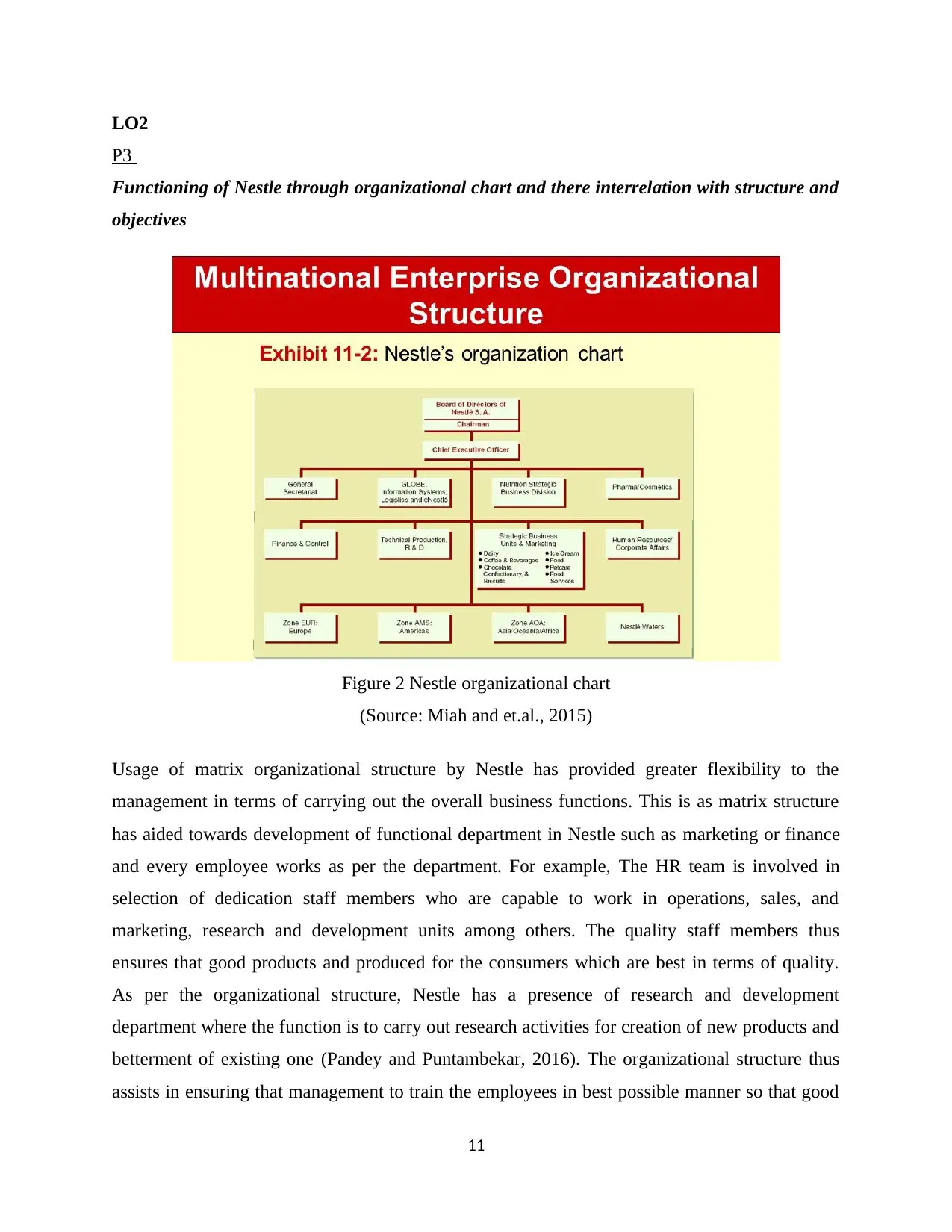
LO2
P3
Functioning of Nestle through organizational chart and there interrelation with structure and
objectives
Figure 2 Nestle organizational chart
(Source: Miah and et.al., 2015)
Usage of matrix organizational structure by Nestle has provided greater flexibility to the
management in terms of carrying out the overall business functions. This is as matrix structure
has aided towards development of functional department in Nestle such as marketing or finance
and every employee works as per the department. For example, The HR team is involved in
selection of dedication staff members who are capable to work in operations, sales, and
marketing, research and development units among others. The quality staff members thus
ensures that good products and produced for the consumers which are best in terms of quality.
As per the organizational structure, Nestle has a presence of research and development
department where the function is to carry out research activities for creation of new products and
betterment of existing one (Pandey and Puntambekar, 2016). The organizational structure thus
assists in ensuring that management to train the employees in best possible manner so that good
11
P3
Functioning of Nestle through organizational chart and there interrelation with structure and
objectives
Figure 2 Nestle organizational chart
(Source: Miah and et.al., 2015)
Usage of matrix organizational structure by Nestle has provided greater flexibility to the
management in terms of carrying out the overall business functions. This is as matrix structure
has aided towards development of functional department in Nestle such as marketing or finance
and every employee works as per the department. For example, The HR team is involved in
selection of dedication staff members who are capable to work in operations, sales, and
marketing, research and development units among others. The quality staff members thus
ensures that good products and produced for the consumers which are best in terms of quality.
As per the organizational structure, Nestle has a presence of research and development
department where the function is to carry out research activities for creation of new products and
betterment of existing one (Pandey and Puntambekar, 2016). The organizational structure thus
assists in ensuring that management to train the employees in best possible manner so that good
11

performance can be rendered so as to fulfill the needs and requirements of consumers. The
managers of this department also keep the staff members motivated enough so that they do their
work diligently. The marketing department at Nestle works on brand management and takes
steps for increasing the overall brand value of the firm all around the globe. This is a most
needed strategy to make the firm a leader in food and beverage sector and also ensure towards
long term sustainability even during times of immense competition (Rezaeegiglo and et.al.,
2014). It is further required to be made sure by the marketing employees that the company is
promoted as a trustworthy brand that provides quality offerings to the consumers. Overall the
matrix structure ensures that the organizational functions are able to adapt themselves as per
changing business needs. It is on account of matrix structure that the company is able to retain its
functions within the organization.
LO3
P4
Macro environmental analysis with respect to operations of Nestle in UK
It is very essential to carry out macro environmental analysis of Nestle by using PESTLE
analysis tool in order to find out what are the impacts of the factors on the overall operations of
the company which can be of positive or negative nature (Bocken and Bocken, 2017). In terms of
political factor, studies suggest that UK has a presence of an overall stable political environment
that has been assisting the overall running of the company in a proper manner. But brexit issue
has somewhere impacted the working of the company as very few consumers will opt for costly
product offered by the company on account of an overall decrease in their purchasing power.
This can impact the sales and revenue figures of the company if brexit issue is not worked on
time (Margea, Hurbean and Artene, 2014). The working of Nestle is also dependent on how UK
maintains its political terms with Brazil as the company gets coffee beans for its products. As of
now, the nation has a presence of good relation with Brazil hence this is likely to favor the
overall operations of the company. It has further been known that Nestle in true sense has been
promoting the health policies laid by UK government by maintaining standards of quality and
hygiene in its operations. It should continue to do so to avoid facing any issue when it starts its
operations in any new nation (Galalae and George, 2017).
12
managers of this department also keep the staff members motivated enough so that they do their
work diligently. The marketing department at Nestle works on brand management and takes
steps for increasing the overall brand value of the firm all around the globe. This is a most
needed strategy to make the firm a leader in food and beverage sector and also ensure towards
long term sustainability even during times of immense competition (Rezaeegiglo and et.al.,
2014). It is further required to be made sure by the marketing employees that the company is
promoted as a trustworthy brand that provides quality offerings to the consumers. Overall the
matrix structure ensures that the organizational functions are able to adapt themselves as per
changing business needs. It is on account of matrix structure that the company is able to retain its
functions within the organization.
LO3
P4
Macro environmental analysis with respect to operations of Nestle in UK
It is very essential to carry out macro environmental analysis of Nestle by using PESTLE
analysis tool in order to find out what are the impacts of the factors on the overall operations of
the company which can be of positive or negative nature (Bocken and Bocken, 2017). In terms of
political factor, studies suggest that UK has a presence of an overall stable political environment
that has been assisting the overall running of the company in a proper manner. But brexit issue
has somewhere impacted the working of the company as very few consumers will opt for costly
product offered by the company on account of an overall decrease in their purchasing power.
This can impact the sales and revenue figures of the company if brexit issue is not worked on
time (Margea, Hurbean and Artene, 2014). The working of Nestle is also dependent on how UK
maintains its political terms with Brazil as the company gets coffee beans for its products. As of
now, the nation has a presence of good relation with Brazil hence this is likely to favor the
overall operations of the company. It has further been known that Nestle in true sense has been
promoting the health policies laid by UK government by maintaining standards of quality and
hygiene in its operations. It should continue to do so to avoid facing any issue when it starts its
operations in any new nation (Galalae and George, 2017).
12
⊘ This is a preview!⊘
Do you want full access?
Subscribe today to unlock all pages.

Trusted by 1+ million students worldwide
1 out of 19
Related Documents
Your All-in-One AI-Powered Toolkit for Academic Success.
+13062052269
info@desklib.com
Available 24*7 on WhatsApp / Email
![[object Object]](/_next/static/media/star-bottom.7253800d.svg)
Unlock your academic potential
Copyright © 2020–2025 A2Z Services. All Rights Reserved. Developed and managed by ZUCOL.





